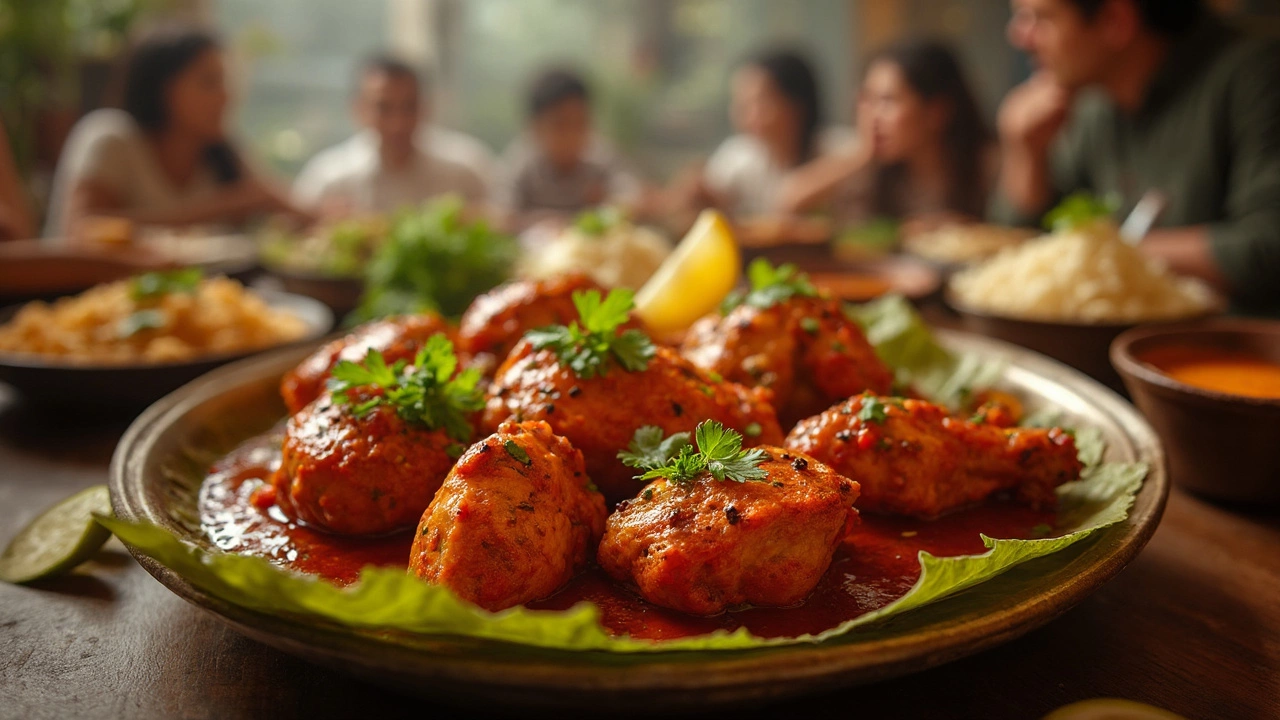Tandoori sauce doesn’t tiptoe onto your taste buds—it makes an entrance. If you’ve ever wondered why tandoori chicken tastes so bold and different from your usual BBQ, it’s all about the sauce. This stuff brings together yogurt, garlic, ginger, smoky spices, and a pop of citrus that hits every part of your tongue.
The magic starts in the spice blend. Think earthy cumin, punchy coriander, a hit of hot chili, and that smoked paprika reddish hue. Most tandoori sauces lean on tangy yogurt, which cools the spice just enough to keep it fun (and not painful). That’s why tandoori chicken tastes creamy and zippy at the same time—it’s not all heat and no balance.
- What is Tandoori Sauce?
- Key Flavors and Ingredients
- How It Tastes on Chicken
- Tips to Make or Choose a Good Tandoori Sauce
- More Than Chicken: Fun Uses for Tandoori Sauce
What is Tandoori Sauce?
Tandoori sauce is a bold, creamy marinade that defines classic Indian dishes like tandoori chicken. The sauce is a mix of full-fat yogurt, tomatoes, and an intense blend of spices. These aren’t just any spices—the base usually includes ground cumin, coriander, chili powder, smoked paprika (for the color and smoky note), turmeric, black pepper, and a bit of garam masala for warmth.
The sauce gets its name from the ‘tandoor,’ a super-hot clay oven that’s been a staple in North India for centuries. But you don’t need a tandoor at home. The marinade is what brings the real flavor, and thanks to its thick, tangy texture, it sticks well to chicken, fish, lamb, and even paneer or veggies.
Core ingredients often include:
- Plain yogurt (acts as a tenderizer and carries the spices)
- Garlic and ginger paste (for rich, sharp undertones)
- Lemon or lime juice (for acidity and freshness)
- Spices: cumin, coriander, chili powder, smoked paprika, turmeric, garam masala
- Salt and sometimes a touch of oil (to make the marinade stick and keep it moist)
Many store-bought tandoori sauces mimic these flavors, but they don’t always use the real-deal spice-to-yogurt ratio. When you make tandoori sauce at home, you can control the tang, heat, and the level of smokiness—tick all those right boxes.
Fun fact: restaurants sometimes boost that classic red color with food dye, but at home, smoked paprika or Kashmiri chili does the trick naturally. Authentic tandoori chicken is always about bold flavors and a sauce that packs a punch, whether you grill, roast, or even air-fry it!
Key Flavors and Ingredients
If you’ve ever tried tandoori sauce and thought, “What IS that flavor?”—here’s what’s really going on. This sauce is built on a foundation of yogurt. Yogurt doesn’t just make it creamy; it tenderizes meat and helps those spices actually stick. That’s why it shows up in pretty much every legit tandoori chicken recipe.
The spices make the magic happen. A classic tandoori sauce will bring together:
- Cumin: Earthy, warm, and a little nutty.
- Coriander: Slightly citrusy with a fresh kick.
- Garam masala: A blend of warming spices, usually including cinnamon, cloves, and cardamom.
- Smoked paprika or Kashmiri chili: Adds deep color and a gentle smokiness.
- Ginger and garlic: For that sharp, savory punch.
Salt balances everything and a pop of lemon juice (or sometimes vinegar) cuts through the richness with needed tang. Traditional tandoori sauce skips cream and butter, unlike tikka or makhani sauces—it’s lighter, so those spices are front and center.
Here’s a peek at what you might actually find in a typical homemade tandoori marinade:
| Ingredient | Role in Sauce |
|---|---|
| Yogurt | Base, creaminess, tenderizes meat |
| Cumin, coriander, garam masala | Main spice flavor |
| Smoked paprika or chili | Heat and red color |
| Ginger, garlic | Sharp, spicy notes |
| Salt, lemon juice | Balance and tang |
Some store-bought versions use food coloring for that classic bright red, but if you care about flavor, look for sauces that use natural chili for color. It doesn’t just look right; it tastes better, too.

How It Tastes on Chicken
Bite into tandoori chicken and you’ll get a flavor combo that’s hard to forget. The marinade clings to the chicken, locking in a smoky, slightly charred taste. Yogurt in the tandoori sauce does more than coat—it actually tenderizes the meat, so the chicken turns out crazy juicy, especially after time in a hot oven or, if you’re lucky, an actual tandoor.
You’ll notice a hit of garlic and ginger first, with chili heat mellowing into the background. The cumin, coriander, and smoked paprika give a nutty and spicy backbone, but the yogurt and lemon juice keep it from getting heavy. It’s all about balance—you get creamy, spicy, tangy, and smoky in every bite.
Here’s what top chef Madhur Jaffrey once said about this:
“It’s not just color—tandoori sauce actually flavors the chicken all the way through, which is the whole deal. The combo of marinating spices and yogurt does the trick.”
If you’re wondering how spicy it gets, it depends on where you get it. At most restaurants in the US or UK, tandoori chicken is more about flavor than blowing out your taste buds. Here’s a quick look at what you’ll usually taste:
| Flavor Note | Intensity |
|---|---|
| Smokiness | Medium to high |
| Spiciness | Mild to medium |
| Tang (Yogurt) | Medium |
| Herbs & Spices | High |
| Sweetness | Low |
Want the best results? Marinate your chicken for at least four hours. Some folks even go overnight for extra flavor. And don’t shy away from grilling—charcoal brings out the real magic in tandoori chicken.
Tips to Make or Choose a Good Tandoori Sauce
If you want the full punch of classic tandoori sauce, you need to pay attention to a couple of must-haves. Don’t grab just any jar, and don’t cut corners with homemade blends. The details matter.
- Yogurt is key. A thick, full-fat yogurt works best. It’s the secret to that creamy bite and clingy texture. Greek yogurt is a great pick, because it’s rich and won’t go runny when you add spices.
- Fresh ginger and garlic make a bigger impact than powders. Grate them right in—tastes sharper and more real.
- Don’t skimp on the spices. You want coriander, cumin, turmeric, paprika, and chili powder. The best pre-made sauces list these up front, so check the label before tossing it into your cart.
- Lemon juice or vinegar is non-negotiable. That tangy zap balances the cream and spice. Not all store sauces have enough of it, so it’s a good sign if you see these near the top of an ingredient list.
Here’s a simple way to build your own homemade tandoori sauce for about 500g of chicken:
- Mix 1 cup Greek yogurt with 2 tablespoons lemon juice.
- Add 1 tablespoon each minced garlic and grated ginger.
- Stir in 2 teaspoons ground cumin, 2 teaspoons ground coriander, 1 teaspoon paprika, 1 teaspoon turmeric, and 1–2 teaspoons chili powder (depending on your heat needs).
- Finish with 1 teaspoon salt. Mix well, then taste and tweak the spices.
Looking for pre-made? Go for brands that don’t bury you in preservatives or sugar. More than 5g sugar per 2-tablespoon serving is just too sweet for proper tandoori chicken. Check for real yogurt near the top and loaded spices—not vague "spice blend."
| Store Sauce | Real Yogurt | Sugar per Serving | Main Spices Listed |
|---|---|---|---|
| Brand A | Yes | 3g | Coriander, Cumin, Chili |
| Brand B | No | 8g | "Spice blend" |
Indian chef Maunika Gowardhan says:
"For real tandoori flavor at home, don’t hold back on the spices and fresh aromatics. Yogurt’s got to be full-fat for the best texture and taste."
Bottom line—good tandoori sauce is never shy with its flavors. Whether making or picking a jar, boldness, balance, and real ingredients win every time.

More Than Chicken: Fun Uses for Tandoori Sauce
Using tandoori sauce only for chicken is like using your phone just to make calls—there’s so much more it can do. The flavors punch through in all sorts of recipes, so don’t be shy about getting creative in your kitchen.
Swipe it on seafood or vegetables before grilling. Shrimp or cauliflower soak up the tangy yogurt and smoky spices just as well as chicken does. Roasting potatoes tossed with tandoori sauce turns them into next-level snacks. Even tofu gets a serious flavor upgrade after just half an hour in a tandoori marinade.
Try it as your new go-to dip. Mix a spoonful of tandoori sauce with Greek yogurt or mayo and suddenly you have a spicy spread for burgers, wraps, or crispy fries. It also wakes up plain rice, turning a boring side into something worth eating on its own.
And hey, if you like pizza, use tandoori sauce as the base instead of regular tomato sauce. Top with paneer, onions, and peppers for a quick “Indian pizza” that’s way better than delivery.
- Tandoori sauce on grilled or roasted fish (especially salmon)
- Mixed into your breakfast eggs for a spicy scramble
- Drizzled over roasted corn or veggies
- As a base for creamy pasta or Indian-inspired mac and cheese
- Tossed with chickpeas for a protein-packed salad
Restaurants in the UK and US have added tandoori-flavored wings and even tandoori tacos to their menus. Clearly, the world doesn’t want to keep these bold flavors just for chicken.
| Popular Non-Chicken Uses (2024 restaurant trends) | Customer Rating (out of 5) |
|---|---|
| Tandoori Nachos | 4.7 |
| Tandoori Cauliflower Steaks | 4.5 |
| Tandoori Seafood Skewers | 4.8 |
Remember, tandoori sauce isn’t a one-trick pony. Keep a jar in your fridge and start experimenting. You’ll find excuses to slather it on just about anything.
